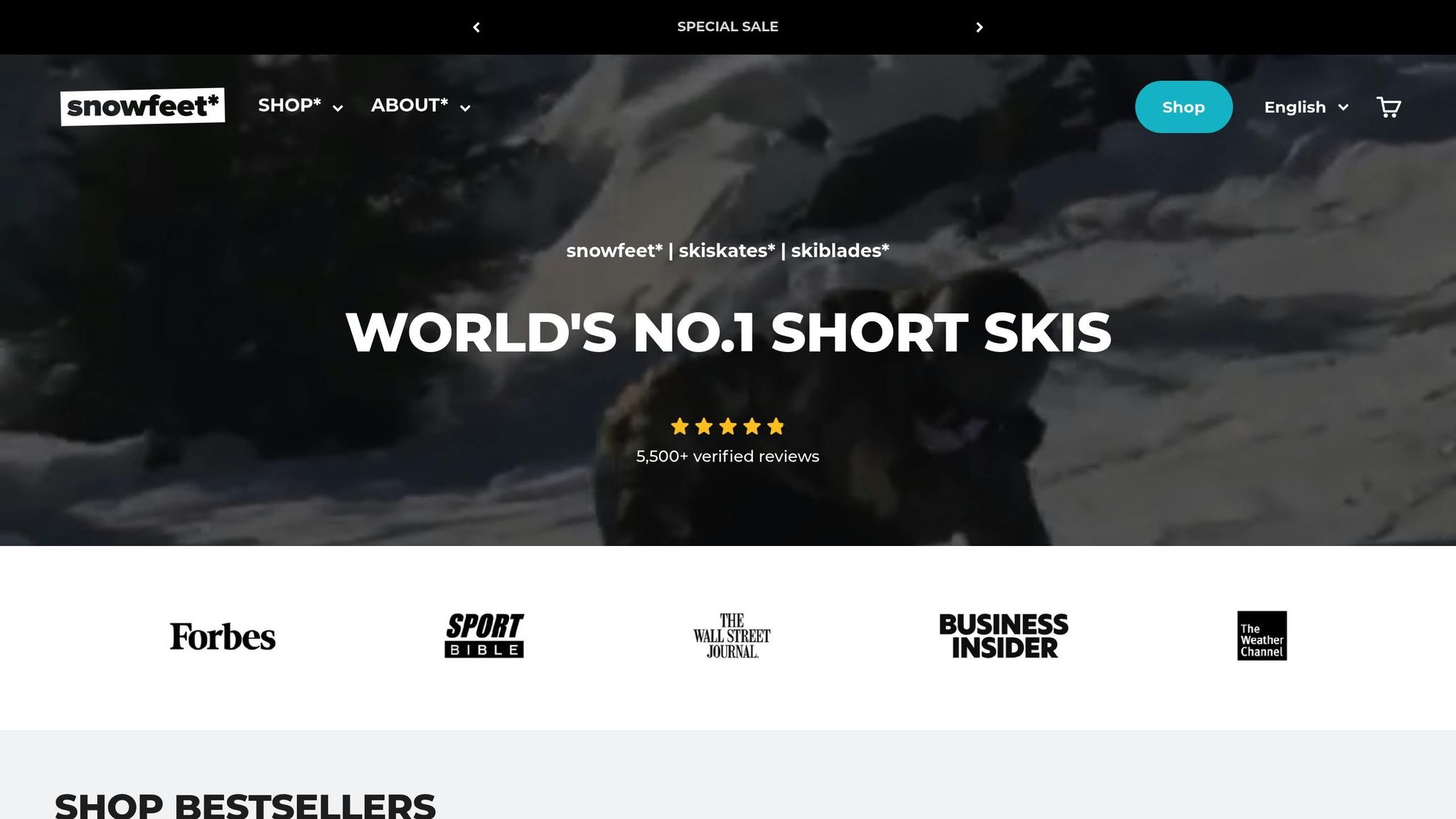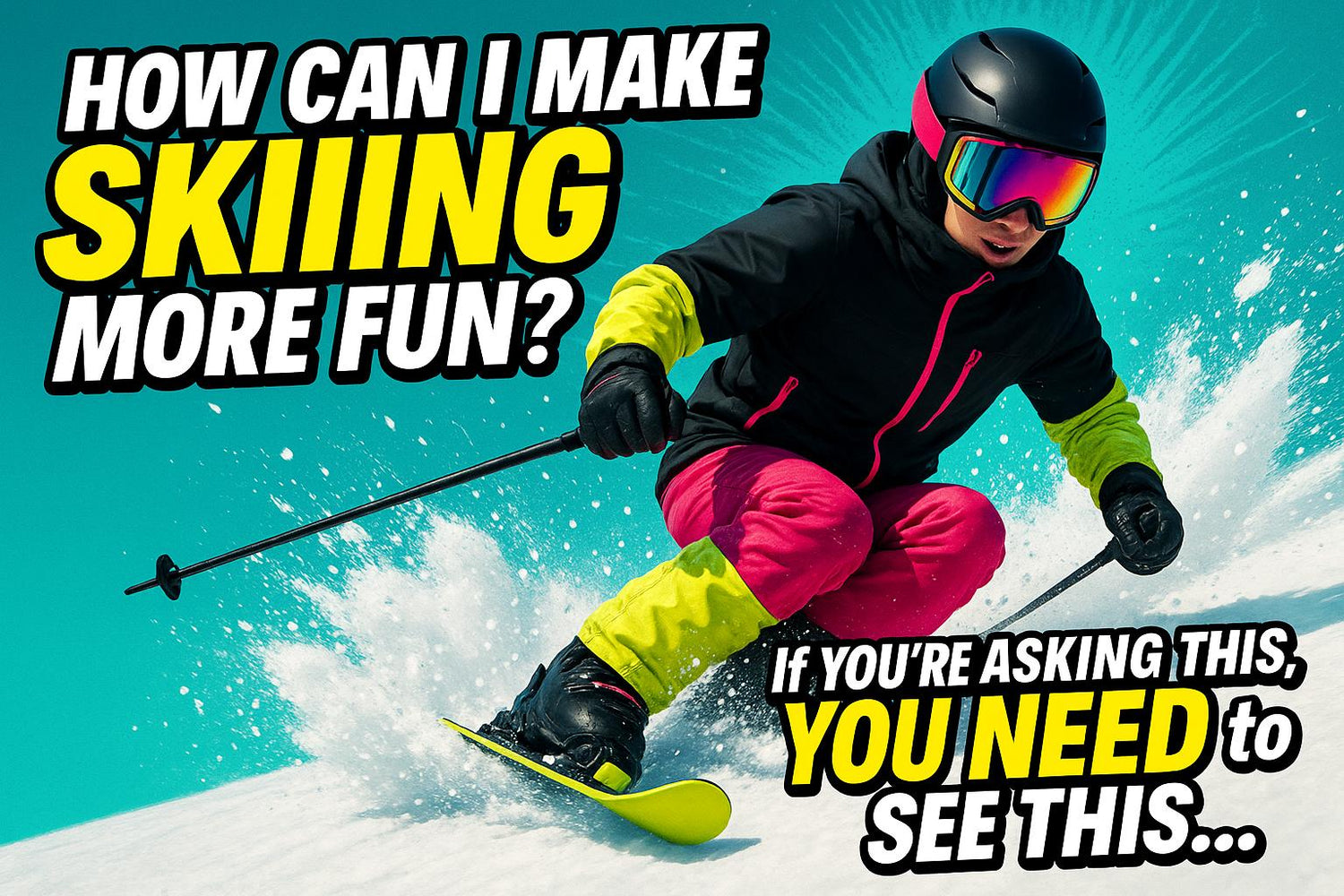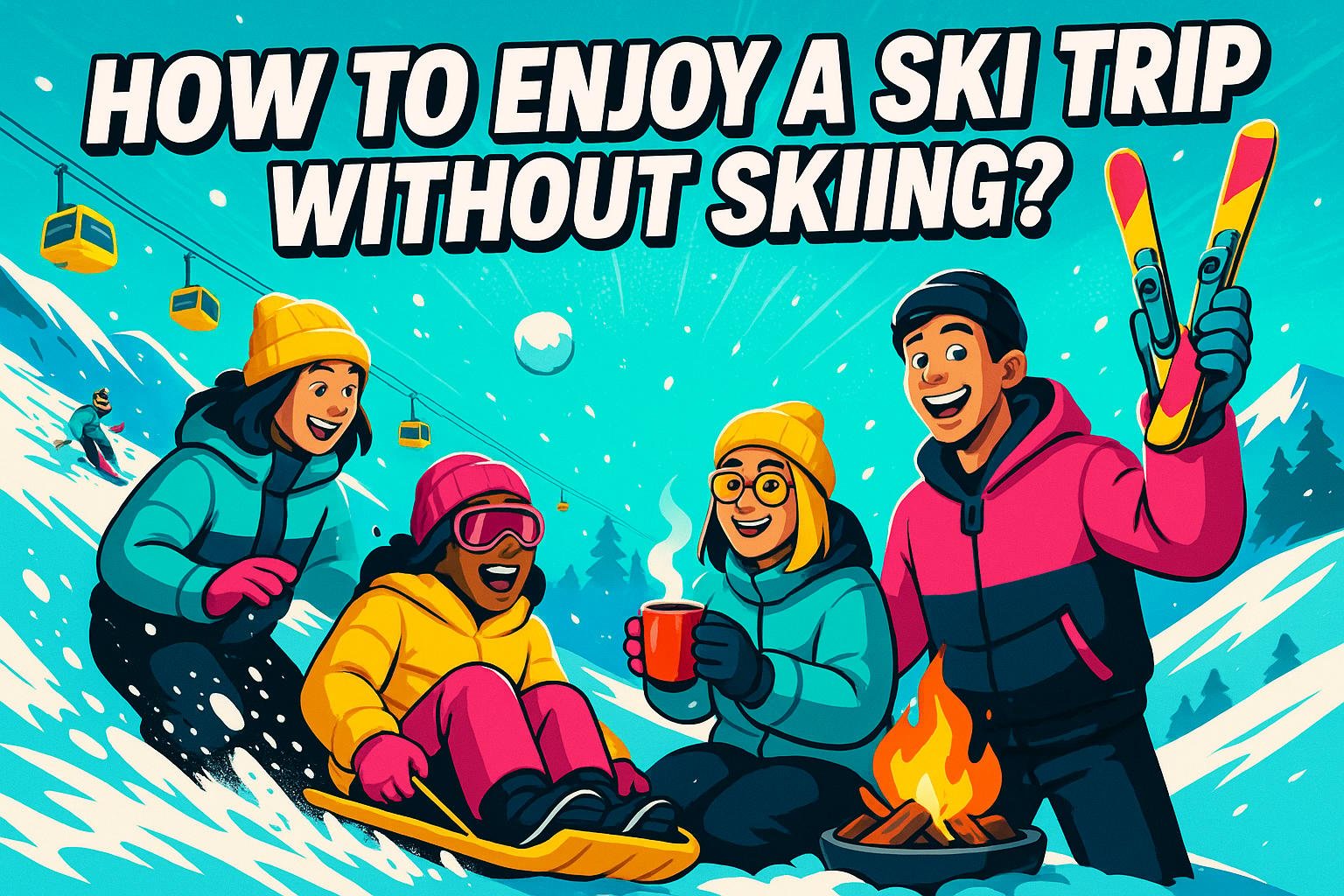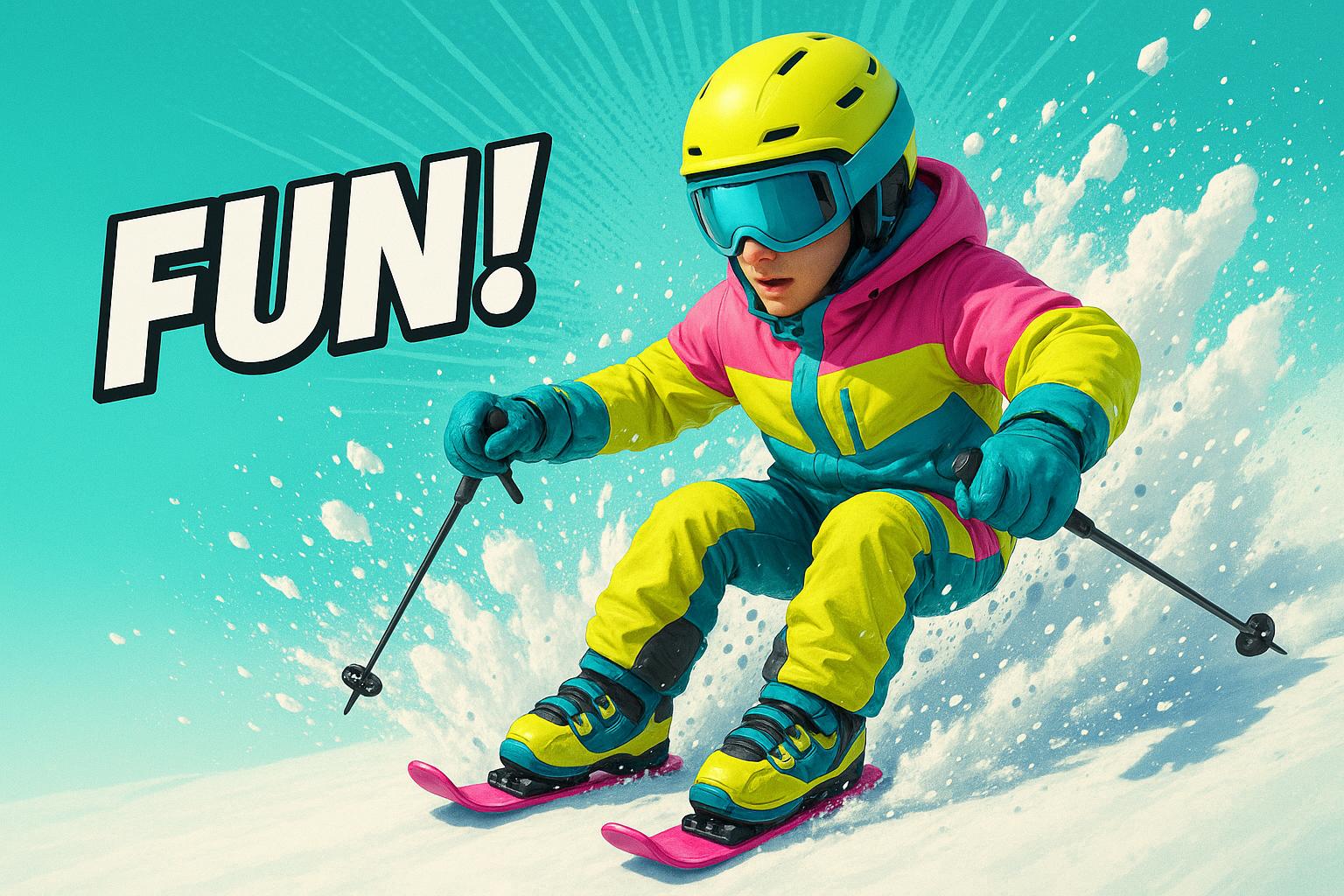Skifahren muss nicht anstrengend oder einschüchternd sein. Wenn Sie genug von schwerer, unhandlicher Ausrüstung haben, können kurze Skier wie Snowfeet das Skifahren einfacher, leichter und angenehmer machen. Hier ist, warum sie eine Überlegung wert sind:
- Kürzere Länge: Traditionelle Skier sind 59–79 Zoll lang, während Snowfeet von 15–47 Zoll reichen, was sie leichter handhabbar macht.
- Leicht & tragbar: Snowfeet sind kompakt genug, um in einen Rucksack zu passen, im Gegensatz zu traditionellen Skiern, die Dachträger benötigen.
- Einsteigerfreundlich: Einfacher zu erlernen mit einer schnellen Lernkurve, perfekt für alle Könnerstufen.
- Kosteneffizient: Snowfeet beginnen bei 140 $, im Vergleich zu traditionellen Ausrüstungen, die 800–1.500+ $ kosten.
- Vielseitig: Verwenden Sie sie auf präparierten Pisten, Snowparks oder sogar im urbanen Gelände.
Schneller Vergleich: Snowfeet vs. traditionelle Skier

| Merkmal | Snowfeet (15–47 Zoll) | Traditionelle Skier (59–79 Zoll) |
|---|---|---|
| Gewicht | Leicht, tragbar | Schwer, benötigt Transportträger |
| Lernkurve | Einfach und schnell | Steiler, oft Unterricht nötig |
| Preisspanne | $140–$650 | $800–$1,500+ |
| Schuhkompatibilität | Normale Winter- oder Snowboardstiefel | Spezielle Skischuhe erforderlich |
| Gelände | Präparierte Pisten, Parks, urban | Meist präparierte Pisten |
Wenn Skifahren sich weniger wie ein Workout und mehr wie Spaß anfühlen soll, könnten Snowfeet’s kurze Skier die Antwort sein. Sie sind einfach zu benutzen, preiswert und für reinen Schneespaß gemacht.
Snowboarder probiert Snowfeet* aus | Welcher Snowfeet* Short Ski ist der Beste? | Snowblades 44, 65, 99 Testbericht
Was sind Snowfeet und warum verändern sie das Spiel?
Snowfeet revolutionieren die Welt des Wintersports mit ihrem kompakten und leichten Design. Während traditionelle Skier von Marken wie Rossignol, Atomic, Head oder Elan typischerweise zwischen 59 und 79 Zoll (150–200 cm) messen, bieten Snowfeet eine viel kleinere Alternative von nur 15 bis 47 Zoll (38–120 cm). Sie verbinden den Nervenkitzel des Skifahrens mit der Beweglichkeit des Skatings, und hier kommt der Clou – sie funktionieren mit deinen normalen Winter- oder Snowboardstiefeln. Das bedeutet, du kannst dir die teuren Skischuhe sparen.
Was Snowfeet auszeichnet, ist ihre Vielseitigkeit. Im Gegensatz zu traditionellen Skiern, die oft am besten für präparierte Pisten und bestimmte Bedingungen geeignet sind, sind Snowfeet so konzipiert, dass sie verschiedene Geländearten bewältigen. Ihr flexibles Design bedeutet, dass du nicht in mehrere Ausrüstungsgegenstände investieren musst, um unterschiedliche Schneeumgebungen zu genießen. Lass uns eintauchen, was diese kleinen Wunder so besonders macht.
Hauptmerkmale der Snowfeet Produkte
Snowfeet Produkte basieren auf drei Hauptideen: Tragbarkeit, Langlebigkeit und Benutzerfreundlichkeit. Nehmen wir zum Beispiel die 38 cm Mini Ski Skates – sie sind klein genug, um sie in einen Rucksack zu stecken, was sie perfekt für spontane Schneeabenteuer oder Reisen mit leichtem Gepäck macht.
Diese kurzen Skier sind aus glasfaserverstärkten Materialien gefertigt, sodass sie robust genug sind, um den Anforderungen des Schneesports standzuhalten und dabei trotzdem leicht bleiben. Die verstellbaren Bindungen lassen sich mit einem normalen Schraubenzieher leicht anpassen, sodass keine teuren Profi-Einstellungen nötig sind.
Ein weiterer großer Pluspunkt? Die Lernkurve ist nicht steil. Wenn du Erfahrung mit Eislaufen, Hockey oder Rollerblading hast, lernst du es schnell. Und weil Snowfeet viel weniger wiegen als traditionelle Skiausrüstung – die oft 15–20 Pfund oder mehr auf die Waage bringt – verbringst du mehr Zeit mit Spaß und weniger Zeit mit Erholen vom Schleppen schwerer Ausrüstung.
Snowfeet vs traditionelle Skimarken
So schneiden Snowfeet im Vergleich zu traditionellen Skiern ab. Während Standard-Ski für Geschwindigkeit auf präparierten Pisten ausgelegt sind und zwischen 59 und 79 Zoll messen, setzen Snowfeet auf Agilität und Spaß. Ihre kürzere Länge – von 15 bis 47 Zoll – ermöglicht schnelle Kurven und präzise Bewegungen mühelos und gibt dir eine Kontrolle, die mit herkömmlichen Skiern schwer zu erreichen ist.
Auch beim Preis punkten Snowfeet. Ein komplettes traditionelles Skiset mit Ski, Stiefeln und Bindungen kostet leicht zwischen 800 und 1.500 $ oder mehr. Snowfeet sind dagegen viel budgetfreundlicher. Die Preise beginnen bei etwa 150 $ für die 38-cm-Mini Ski Skates und reichen bis zu rund 650 $ für die 120-cm-Modelle. Und da du deine normalen Winter- oder Snowboardstiefel verwenden kannst, musst du nicht extra für Spezialschuhe oder Anpassungen zahlen.
Barrierefreiheit ist ebenfalls ein echter Game-Changer. Traditionelles Skifahren erfordert oft teure Ausrüstung, Unterricht und spezielle Bedingungen, was es für viele unzugänglich macht. Snowfeet machen den Schneesport zugänglicher. Sie sind leichter zu erlernen, an verschiedene Bedingungen anpassbar und ideal für Familien, ältere Erwachsene oder alle, die traditionelles Skifahren zu einschüchternd oder körperlich zu anspruchsvoll finden.
Snowfeet Produktoptionen
Snowfeet bietet drei spannende Modelle für Schneeliebhaber: Mini Ski Skates für Portabilität, Skiblades für Präzision und Vielseitigkeit sowie Skiskates für urbane Abenteuer. Schauen wir uns an, was jede Option zu bieten hat, damit du die perfekte Wahl für deinen Winterspaß findest.
Mini Ski Skates (38/50 cm): Leicht und vielseitig
Wenn Portabilität für dich oberste Priorität hat, sind die Mini Ski Skates eine fantastische Wahl. Die 38-cm-Version (ca. 15 Zoll) ist ultraleicht und leicht zu verstauen – perfekt für spontane Schneetouren. Für alle, die etwas mehr Stabilität suchen, bietet das 50-cm-PRO-Modell mehr Halt und bleibt dennoch kompakt, zu einem fairen Preis von 230 $. Beide Modelle sind aus robustem Kunststoff gefertigt und für den regelmäßigen Gebrauch gemacht, ohne das Budget zu sprengen.
Diese Skates sind besonders toll für Anfänger, die in den Schneesport hineinschnuppern wollen, ohne in traditionelle Ausrüstung zu investieren. Ab nur 140 $ bieten sie eine spaßige und zugängliche Möglichkeit, die Pisten zu erobern. Wie ein 69-jähriger Skifahrer aus North Las Vegas berichtete:
"Ich hatte so viel Spaß – so einfach zu fahren."
Egal, ob du Geschwindigkeit, Portabilität oder einen schnellen Einstieg in den Schneesport suchst – Mini Ski Skates liefern.
Skiblades (65-120 cm): Kontrolle und Agilität auf allen Terrains
Für ein skigerechtes Erlebnis mit zusätzlicher Wendigkeit sind Skiblades die beste Wahl. Diese kurzen Ski gibt es in drei Größen: 65 cm (ca. 26 Zoll), 99 cm (etwa 39 Zoll) und 120 cm (ungefähr 47 Zoll). Jede Größe ist für unterschiedliche Vorlieben konzipiert, bietet aber alle hervorragende Kontrolle, besonders auf abwechslungsreichem Gelände.
Das 65-cm-Modell, zum Preis von 400 $, ist ein Favorit fürs Carven und Tricks im Snowpark. Wenn du bei höheren Geschwindigkeiten mehr Stabilität suchst, bieten die 99-cm- und 120-cm-Varianten zusätzliche Länge, ohne die Wendigkeit zu opfern, die diese Skiblades so spaßig macht. Ein Skifahrer aus Prag brachte es perfekt auf den Punkt:
"Sie sind agil und bequem – Snowfeet haben ein ganz neues Pisten-Erlebnis eröffnet."
Ob du nun über präparierte Pisten flitzt oder abseits der Wege unterwegs bist – Skiblades bieten eine einzigartige Mischung aus Präzision und Spaß.
Skiskates (44 cm): Das Beste aus Skifahren und Skaten
Skiskates verbinden den Nervenkitzel des Skifahrens mit der Wendigkeit des Eislaufens. Mit 44 cm (etwa 17 Zoll) sind sie kompakt, haben aber ordentlich Power. Gefertigt mit einem starken Holzkern, sind sie robuster als die Mini Ski Skates und meistern sowohl Abfahrten als auch flaches Gelände. Perfekt für Sprünge, enge Passagen oder sogar Stadterkundungen, kosten Skiskates 330 $.
Auch wenn sie für absolute Anfänger etwas Übung erfordern, bringen sie eine ganz neue Dimension in den Schneesport. Hockeyspieler Paul Ague aus Phoenix beschrieb sie als "Game Changer":
"Hat sich wirklich wie Skaten angefühlt."
Wenn du etwas anderes suchst und den Schnee auf ganz neue Weise entdecken möchtest, sind Skiskates einen Versuch wert.
Welches Snowfeet Modell passt zu dir?
Es kommt ganz darauf an, was du suchst. Willst du etwas super Portables mit einer einfachen Lernkurve? Dann sind die Mini Ski Skates genau richtig. Hast du Lust auf ein skiahnliches Erlebnis mit scharfem Handling? Skiblades sind deine beste Wahl. Bereit, etwas völlig Neues auszuprobieren? Skiskates werden dich nicht enttäuschen. Egal, wofür du dich entscheidest, Snowfeet bietet dir ein spaßiges und unvergessliches Winterabenteuer.
sbb-itb-17ade95
So holst du das meiste Vergnügen mit Snowfeet heraus
Snowfeet stehen für schnelle Reaktionen und fließende Bewegungen, was sie zum Riesenspaß macht. Ihr Design ist super reaktionsfreudig, sodass sie sich fast sofort an jede deiner Bewegungen anpassen. Das bedeutet, du kannst dich weniger auf schwierige Techniken konzentrieren und mehr einfach die Fahrt genießen.
Die Beherrschung der Short Ski Bewegungen
Mit Snowfeet musst du dich nicht bei jeder Kurve voll festlegen – diese kleinen Skier reagieren sofort und geben dir die Freiheit, unterwegs schnell Anpassungen vorzunehmen. Genau das macht sie so spaßig und leicht zu lernen.
So startest du:
- Haltung und Balance: Halte die Knie leicht gebeugt und das Gewicht zentriert. Drücke die Schienbeine sanft gegen die Skischuhe, um dein Gewicht nach vorne zu verlagern und die Kontrolle zu verbessern.
- Schnelle Kurven: Nutze die Skikanten für kurze, kontrollierte Kurven statt der langen, weiten Schwünge, die du mit traditionellen Skiern machst.
- Geschwindigkeitskontrolle: Um langsamer zu werden, probiere die Keiltechnik – die Skispitzen nach innen drehen, die Kanten in den Schnee drücken und die Augen nach vorne richten.
- Entspannte Haltung: Halte die Hände oben, die Schultern gerade und lass die Beine das Steuern übernehmen.
Wenn du diese Grundlagen beherrschst, bist du bereit, verschiedene Gelände mit Selbstvertrauen zu meistern.
Verschiedene Gelände mit Snowfeet erkunden
Nachdem du dein Gleichgewicht und die Kantentechnik gemeistert hast, ist es Zeit, deine Fähigkeiten auf verschiedenen Geländen zu testen.
-
Präparierte Pisten: Snowfeet sind am besten auf festen, gut gepflegten Pisten. Diese Hänge sind perfekt, um schnelle Kurven und Kantentechnik zu üben. Frühjahrsskifahren macht besonders Spaß – geh früh auf die Piste, wenn der Schnee noch fest ist, und vermeide später matschige Bedingungen. Wie das Snowfeet Team sagt:
"Das Frühjahrsskifahren übertrifft die anderen Jahreszeiten in Sachen Spaß für Skifahrer, von Anfängern bis zu Experten. Mit längeren Tagen, mehr Sonne und einer angenehmen warmen Brise entsteht die perfekte Atmosphäre."
- Snowparks: Wenn du abenteuerlustig bist, ab in den Snowpark. Die kürzere Länge der Snowfeet (wie die 65 cm Skiblades) macht sie ideal zum Carven, für enge Kurven und sogar für coole Tricks.
- Urbanes und flaches Gelände: Snowfeet sind nicht nur für die Pisten. Ihre kompakte Größe ermöglicht es dir, urbane Gebiete und flache Flächen zu erkunden, wo traditionelle Skier nicht funktionieren würden.
Halte deine Ausrüstung in gutem Zustand, während du verschiedene Gelände erkundest. Feile die Metallkanten und wachse die Beläge, um Geschwindigkeit und Kontrolle zu erhalten. Die gute Nachricht? Snowfeet Bindungen lassen sich zuhause mit nur einem Schraubenzieher leicht einstellen – kein Profi-Tuning nötig.
Ein Tipp: Meide steile Hänge und tiefen Pulverschnee mit den kürzeren Snowfeet Modellen. Sie sind am besten auf präparierten Pisten, moderaten Hängen und Gelände-Features. Zum Beispiel sind die 38 cm Mini Ski Skates perfekt für sanfte Hänge und urbane Abenteuer, während die 120 cm Skiblades anspruchsvolleres Gelände meistern.
Mit Snowfeet sind die Möglichkeiten endlos und der Spaß garantiert. Geh raus und probier sie aus!
Snowfeet vs Traditionelle Skiausrüstung: Vollständiger Vergleich
Bei der Entscheidung zwischen Snowfeet und traditioneller Skiausrüstung kommt es ganz darauf an, welche Art von Erlebnis du suchst. Marken wie Rossignol, Atomic, Head und Elan setzen seit langem auf längere Skier wegen ihrer Stabilität auf präparierten Pisten. Snowfeet hingegen dreht den Spieß um und legt den Fokus auf Portabilität, einfache Handhabung und den puren Spaß an der Freiheit auf der Piste.
Traditionelle Skier sind auf Stabilität ausgelegt, besonders bei höheren Geschwindigkeiten. Snowfeet hingegen verfolgt einen anderen Ansatz. Sie sind leicht, kompakt und anfängerfreundlich konzipiert. Wie das Snowfeet Team sagt:
"Im Vergleich zu langen Skiern sind kurze Skier in jeder Hinsicht einfacher: Sie fühlen sich leichter an den Füßen an, sind einfach zu tragen und leichter zu beherrschen."
Vergleichstabelle: Snowfeet vs Traditionelle Skier
| Merkmal | Snowfeet Produkte | Traditionelle Skier (Rossignol, Atomic, Head, Elan) |
|---|---|---|
| Längenbereich | 38–120 cm | 150–190+ cm |
| Gewicht | Ultraleicht und tragbar | Schwerer; oft Dachgepäckträger nötig |
| Lernkurve | Schnelle und einfache Beherrschung | Steilere Lernkurve; meist Unterricht erforderlich |
| Manövrierfähigkeit | Inline-Skating-ähnliche Agilität | Weniger wendig in engen Bereichen |
| Tragbarkeit | Rucksackfreundlich | Benötigt spezialisierten Transport |
| Gelände-Vielseitigkeit | Ideal für präparierte Pisten, Parks und urbane Spots | Meist für präparierte Pisten |
| Körperliche Anstrengung | Minimale Ermüdung bei natürlicher Haltung | Höherer Energiebedarf durch anstrengendere Positionierung |
| Preisspanne | Etwa 140–650 $ | Ungefähr 300–1.500+ $ (plus Bindungen und Schuhe) |
| Schuhkompatibilität | Funktioniert mit Winterschuhen, Snowboardboots oder Skischuhen | Benötigt spezielle Skischuhe |
| Kurvenradius | Schnelle, scharfe Kurven | Besser für lange, weite Schwünge |
Dieser Vergleich zeigt, wie Snowfeet eine frische, flexible Art bietet, Ski zu genießen.
Warum Short Skis besser für Spaß und Freiheit sind
Short skis wie Snowfeet bringen eine ganz neue Leichtigkeit und Freude auf die Piste. Sie sind weniger körperlich anstrengend, was bedeutet, dass du mehr Zeit mit Skifahren verbringen kannst, ohne dich zu verausgaben. Das heißt längere Sessions, mehr Erkundungen und – seien wir ehrlich – mehr Spaß.
Das Design von Snowfeet ahmt die Wendigkeit von Skates nach, was enge Kurven und das Navigieren durch verschiedenes Gelände zum Kinderspiel macht. Außerdem reduziert ihre natürliche Haltung die Belastung, sodass du dich nach jeder Abfahrt nicht wie nach einem Workout fühlst.
Ein weiterer großer Vorteil? Verzeihung. Fehler passieren, besonders wenn du neu im Skifahren bist oder neue Moves ausprobierst. Aber wie das Snowfeet Team erklärt:
"Short skis sind verzeihender als lange Ski, also wenn du einen kleinen Fehler machst, kannst du dich damit wieder herausfahren."
Diese verzeihende Eigenschaft macht Snowfeet zur großartigen Wahl für Anfänger und erfahrene Skifahrer gleichermaßen, reduziert Stürze und macht den Sport zugänglicher.
Und sprechen wir über Vielseitigkeit. Traditionelle Ski sind meist für präparierte Pisten gemacht, aber Snowfeet lässt dich variieren. Ob du die Hänge hinunterfährst, durch einen Park cruisest oder sogar in der Stadt Ski läufst – ihre kompakte Größe macht alles möglich. Kein Schleppen von sperrigem Equipment oder Dachgepäckträgern – einfach in den Rucksack packen und los.
Endlich ist die Lernkurve mit Snowfeet erfrischend kurz. Statt Wochen (und ein kleines Vermögen) mit Unterricht zu verbringen, um lange Ski zu meistern, kannst du Snowfeet fast sofort beherrschen. Mit weniger Aufwand beim Drehen und Stoppen öffnen sie die Tür für jeden, Ski zu genießen, unabhängig von Können oder Kraft.
Fazit: Verändere dein Skierlebnis mit Snowfeet
Snowfeet-Produkte bringen frischen Wind ins Skifahren. Vergiss das Schleppen von schwerer, klobiger Ausrüstung oder das Beherrschen komplizierter Techniken. Snowfeet macht alles zum Spaß und zur Freiheit und bringt die Freude am Wintersport zurück.
Der Beweis liegt in den Zahlen – über 50.000 Menschen genießen bereits Snowfeet, mit Kundenbewertungen, die durchweg zwischen 4,9 und 5,0 Sternen liegen. Das ist kein vorübergehender Trend; es ist eine Veränderung hin zu einem einfacheren und spaßigeren Skierlebnis für alle. Tausende zufriedene Nutzer bestätigen diese Aussage.
Was Snowfeet auszeichnet, ist, wie sie die üblichen Hindernisse des traditionellen Skifahrens beseitigen. Keine sperrigen Stiefel. Keine steile Lernkurve. Mit Snowfeet schnallst du sie einfach an und los geht's. Ob du die Pisten hinunterfährst, einen Hügel in der Nachbarschaft hinabgleitest oder sogar im eigenen Garten Ski fährst – diese kompakten Ski machen alles möglich.
Die Vielseitigkeit von Snowfeet verändert, wie du den Winter erlebst. Die 38 cm Mini Ski Skates passen perfekt in deinen Rucksack und sind ideal für spontane Schneeabenteuer. Die 99 cm Skiblades bieten die perfekte Balance zwischen Kontrolle und Leistung und sorgen für eine sanftere Fahrt ohne die Einschüchterung langer Skier. Und mit Preisen ab nur 140 $ bekommst du viel Leistung fürs Geld. Jedes Snowfeet Modell bringt seine eigene einzigartige Stimmung ins Gelände und macht jeden Ausflug zum neuen Abenteuer.
Warum Snowfeet die Zukunft des Spaßes auf der Piste sind
Snowfeet schreibt die Regeln des Skifahrens neu. Während traditionelle Skimarken auf Geschwindigkeit und technische Details setzen, geht es bei Snowfeet um reinen Spaß. Und das ist nicht nur Marketing – Nutzer wie Jakub F bringen es auf den Punkt:
"Snowfeet haben für mich ein ganz neues Pisten-Erlebnis eröffnet – du kannst mit deinen Kindern, deinen Freunden und sogar mit der Snackbar mithalten. Und man fühlt sich irgendwie wie ein Ninja auf der Piste (zumindest ging es mir so)."
- Jakub F, Snowfeet Nutzer
Das bringt es perfekt auf den Punkt – Snowfeet verwandelt das Skifahren in etwas Spielerisches und Aufregendes. Das leichte Design bedeutet weniger Ermüdung, während die schnelle Wendigkeit es dir erlaubt, mühelos durch volle Pisten zu gleiten. Außerdem eröffnet das hybride Skating-Ski-Design eine Welt voller Tricks und Sprünge.
Egal, ob du dich für die ultra-portablen 38 cm Mini Ski Skates, die geländegängigen 99 cm Skiblades oder die parkfreundlichen 44 cm Skiskates entscheidest, du wählst Ausrüstung, die das Skifahren wieder spaßig macht. Kein Stress, kein Aufwand – einfach gute Zeiten im Schnee.
Der Spaß beginnt in dem Moment, in dem du die Snowfeet anschnallst. Es ist ein Wintersport, der einfach, spontan und richtig unterhaltsam ist. Mit Snowfeet ist Skifahren nicht nur etwas für Profis oder Technikfreaks – es ist für alle.
FAQs
Sind Snowfeet für Anfänger sicherer als traditionelle Skier?
Ja, Snowfeet Produkte wie Skiblades und Mini Ski sind speziell für Anfänger entwickelt und bieten eine sicherere und benutzerfreundlichere Alternative zu traditionellen Skiern. Ihre kürzere Länge und das leichte Design machen sie viel einfacher zu kontrollieren, was besonders wichtig ist, wenn man gerade erst das Gleichgewicht und die Steuerung lernt. Diese zusätzliche Kontrolle hilft, Stürze zu reduzieren und gibt Anfängern mehr Selbstvertrauen auf der Piste.
Traditionelle Skier können sich manchmal schwer und überwältigend anfühlen, besonders für Anfänger. Das kompakte Design von Snowfeet ändert das Spiel – es ermöglicht schnellere Anpassungen und sanftere Kurven. Das macht das Lernen nicht nur einfacher, sondern auch viel spaßiger. Wenn Sie neu im Skifahren sind oder einfach eine entspanntere, zugänglichere Art suchen, die Pisten zu erobern, sind Snowfeet definitiv eine Überlegung wert.
Kann ich Snowfeet auf steilen Hängen oder im tiefen Pulverschnee verwenden?
Ja, Snowfeet Produkte, besonders ihre Skiblades, sind dafür gebaut, steile Hänge und tiefen Pulverschnee mühelos zu meistern. Dank ihres kompakten Designs bieten sie hervorragende Manövrierfähigkeit und Kontrolle, was sie zu einer soliden Wahl für abenteuerliche Gelände macht. Nehmen Sie zum Beispiel die 120 cm Skiblades – sie bieten große Stabilität bei schnellen Abfahrten und steilen Hängen. Die 65 cm Skiblades hingegen sind ideal, um enge Passagen zu navigieren und leicht durch Pulverschnee zu gleiten.
Ein herausragendes Merkmal der Snowfeet Skiblades ist ihre breite Auflagefläche, die ihnen hilft, im Tiefschnee zu schweben. Das bedeutet, Sie können auch bei pulvrigen Bedingungen eine sanfte, spaßige Fahrt genießen. Im Gegensatz zu traditionellen Skiern, die sich oft sperrig und schwer handhabbar anfühlen, bieten Snowfeet Skiblades eine leichte, wendige Alternative, die das Skifahren spannend und zugänglich hält, ohne Leistung einzubüßen.
Wie pflege und justiere ich meine Snowfeet für das beste Skierlebnis?
Um Ihre Snowfeet in Topform zu halten, hilft regelmäßige Pflege enorm. Beginnen Sie mit dem Wachsen der Beläge alle 4–6 Einsätze. Das sorgt für müheloses Gleiten und verhindert, dass Schnee kleben bleibt. Wenn Ihnen die Kanten etwas stumpf vorkommen – besonders nach eisigem Gelände – nehmen Sie sich Zeit, sie zu schärfen. Das gibt Ihnen bessere Kontrolle und sorgt für eine geschmeidige Fahrt.
Wenn es um Anpassungen geht, prüfen Sie, ob die Befestigungen richtig sitzen. Sie können die Sicherheitsknöpfe leicht lösen und neu positionieren, um die perfekte Balance zwischen Komfort und Stabilität zu finden. Snowfeet sind so konzipiert, dass sie einfacher zu justieren sind als traditionelle Skier, sodass diese kleinen Änderungen schnell und schmerzlos sind. Mit ein wenig Pflege genießen Sie jedes Mal eine sanftere und angenehmere Fahrt!


































Hinterlassen Sie einen Kommentar
Diese Website ist durch hCaptcha geschützt und es gelten die allgemeinen Geschäftsbedingungen und Datenschutzbestimmungen von hCaptcha.